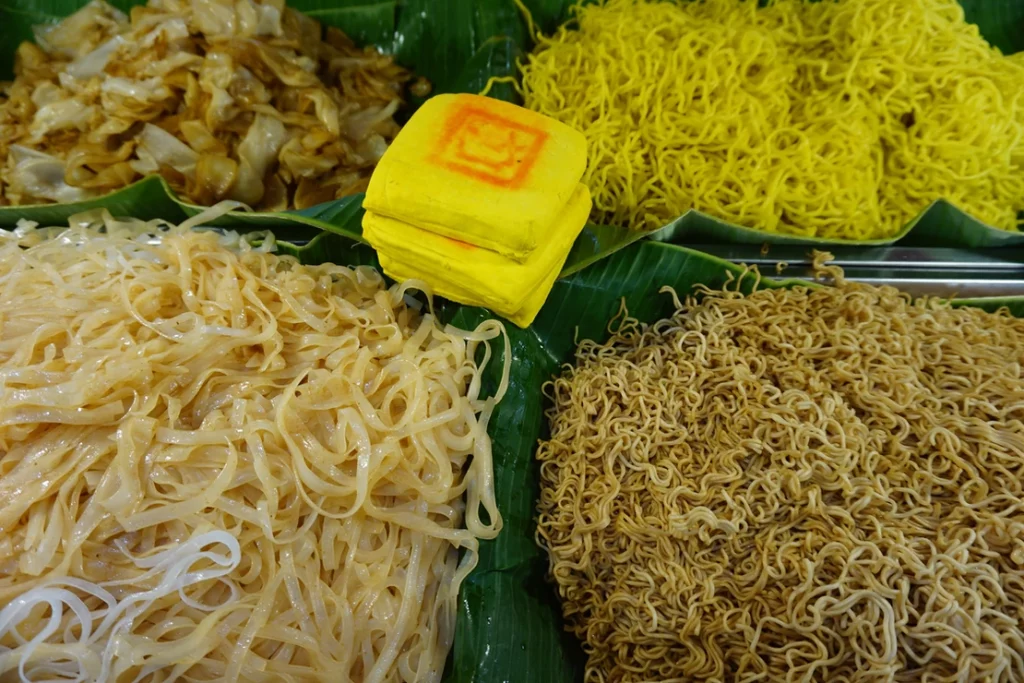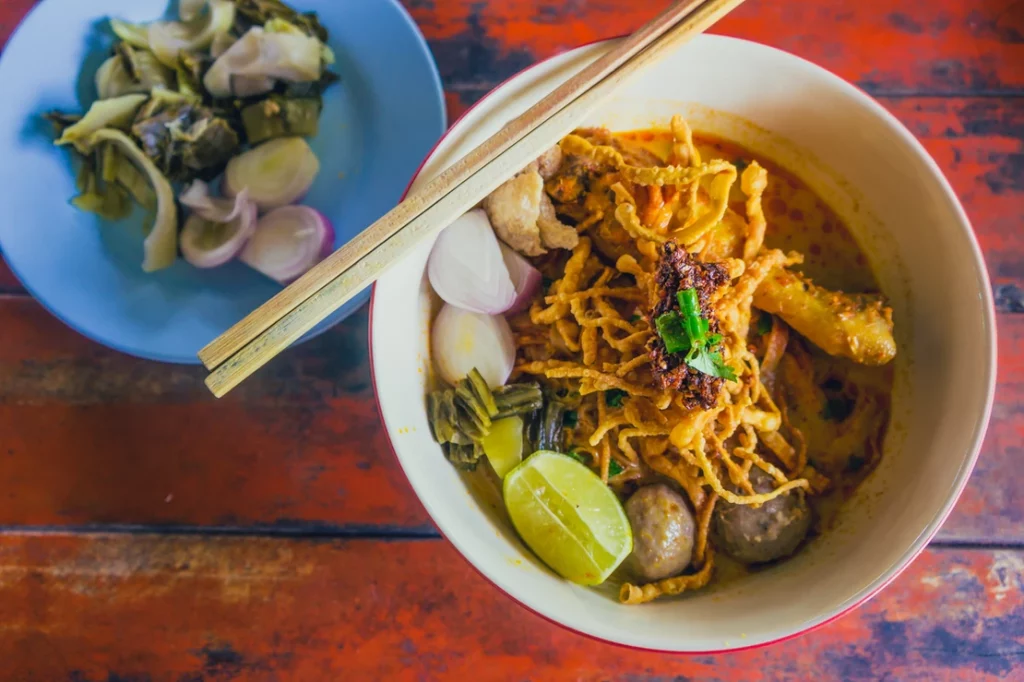Tuk Tuk Tours
Explore Bangkok by the iconic tuk tuk
All you need to know about noodles in Thailand!
Noodle dishes, or as the Thais call it, “guay tiew,” is always a popular option for locals when casually eating. Most noodle dishes are also something simple if you want to learn to cook Thai food. Some popular options include Pad Thai, Kanom Jeen, and Pad Kee Mao, although this is only the beginning of the long list of noodle dishes you can try when you are in Thailand. You could spend a month in Thailand and try a different noodle dish every day!
There are many noodle dishes that are usually made using a specific type of noodle, but equally many dishes where you can choose the type of noodle. In this guide, we will introduce the different types of noodles and the dishes that are made from them.

There are many dishes where you get to select the noodles you want it to be cooked with. These use the most common noodles in Thailand. In Thai, the word “Sen” is a word used to call actual noodle itself and usually describe rice noodles.
Sen Yai: “Yai” means “big” and is called so as this is a wide flat noodle.
Sen Lek: “Lek” means “small” and is called so as it is a thin noodle
Sen Mii: This noodle is thinner still and a bit harder.
Bamee: This is egg noodle
Mama: This is instant noodles. While you may find it strange, these noodles are often used in salads and noodle dishes.
Woonsen: These are glass noodles and are used in many dishes.
Khanom Jeen: These are stickier fermented rice noodles that are usually eaten with curry-like gravies but can also be added to dishes like papaya salad. Often eaten as a substitute for rice
Noodles can be eaten dry, called “haeng” or with broth called “naam.” There are Thai noodle dishes that feature meats, meatballs, gravy or “rad na,” and come in various different types of soups which can be spicy, sweeter, made with a stock base or even with pig blood! If you are looking for dry noodle dishes, you might be thinking Pad Thai or Pad See Ew. The flat, thicker noodles that come with thick gravy are called “rad na.” If you want a curry base, you might enjoy “Nam Ngiew” or “Kao Soi.” If you are looking for a sweeter, more tasteful noodle dish, you should check out “kuay tiew rua,” a soup made of pig’s blood.
When you travel around Thailand, you will see plenty of noodle shops, no matter what city you’re in. All across the country, noodle shops can be easily found, even during the hottest season of the year!
Some regions may prefer or have different preferences when it comes to different variations of soup, noodles, toppings, and sides. Most of the time, with a regular Thai noodle dish, you will get a bone marrow stock soup with some pork meatballs; this is the basic one that you can find anywhere, although you will also have the option of noodle width, style of soup, and meat options. Go around and try the different varieties available in different regions. Enjoy your time in Thailand by eating some delicious, flavorful noodles!
Wherever you are, you will usually find the following condiments so you can flavour your noodles to your desired taste: sugar, fish sauce, vinegar and dried chilli flakes. Season and enjoy!

“Guay Tiew”: This is a very generic term for noodle dishes and can take many forms. E.g. Duck Noodles, Fish Ball Noodles, Chicken Noodles….. You usually get to chose what noodle you want (from the list above) and it is your choice as to whether you want it as a noodle soup or whether you want it dry.
Boat Noodle (Guay tiew rua): A very popular choice and get’s its name from the fact that this dish used to be served by vendors who would sell along the canals from their small wooden boats. Usually you can get either beef or pork versions. It is made using a strong flavoured broth that traditionally contains the animal blood, although in many places these days you can ask for it without blood. In addition it contains meat and meat balls. Select the noodles of your choice. Many places serve it in very small bowls for 10-15THB per bowl, but expect to order lots of bowls!
Pad Thai: Probably Thailand’s most famous noodle dish. It is made from a special noodle called Sen Chan, which comes from Chantaburi province. The secret to the flavor is in the Pad Thai sauce, which combines sour flavours from tamarind with a touch of sweetness. Traditionally Pad Thai is made with shrimps (both fresh and dried) and the other core ingredients are beansprouts and tofu.
Pad See Ew: Literally, this means stir fry with soy sauce. This is a noodle dish which generally uses Sen Yai noodles and as the name suggestsm the main flavouring comes from Soy Sauce. It’s common to also include cabbage and a meat or seafood of your choice.
Kuay Tiew Kua Gai: This is the underdog of Thai noodle dishes. Not so well known but those who try it, love it. “Kua” means fried over a very hot flame and “Gai: is chicken. This dish uses Sen yai noodles combined with chicken and egg, all fried together. Usually, this is severed with lettuce on the side and with sweet chilli sauce.
Pad Kee Mao: Known in English as “Drunken Noodles”. The “Drunken” supposedly came from the fact it was a later night dish. This dish is traditionally made with ground (or sliced) pork, sen yai noodles and plenty of fresh basil. Seasoned with chillies, vinegar and sweet soy sauce. In Thailand you may also find it served with spaghetti.
Rad Na: A favourite among locals but often has a love-it or hate-it impact with foreigners. “Rad Na” literally means “on top of” and is usually described as noodles with gravy on top. Often people just don’t think it is a Thai dish and in fact it is certainly is more of a Thai Chinese dish (as are most noodle dishes). The gravy itself is made from cornflour, soy sauce and egg. Usually it is made from sen yai noodles and served with chicken, pork or seafood. Kale is also added.
Yum Mama / Yum Woonsen: These are noodle salads made from simple re-hydrated noodles (mama or woonsen). Simple, refreshing and can be very spicy! Often mixed with minced pork or shrimps and seasoned with lime juice, chili, coriander etc. Whilst there are traditional recipes, you in theory can add what ever you like to it and many would use the seasoning sachet from the instant noodles.
Guay Jub: This is a peppery soup based noodle dish that is associated with it’s own unique noodle. The guay jub noodle is a square sheet noodle that when boiled rolls up into a tube. Guay jub is almost exclusively a pork based dish and the best versions comes with crispy pork. Be aware that by default it comes with “insides” in it.
Khanom Jeen: As mentioned above “Khanom jeen” refers to the type of noodle but in many restaurants it is a meal in itself and you get to chose from a range of unique curries and sauces that you eat with it. While you can eat it with green curry, there are many curries that are exclusively eaten with Khanaom Jeen, and these include “nam ya” and “nam ngiao”.
Kao Soi: This is a signature dish of Northern Thailand and with Burmese influence. It is a curried noodle soup made from a broth that combines coconut milk and red curry paste. The soup is served with flat egg noodles and a choice of meat, which usually includes chicken, beef, and pork. It is topped with a handful of crisp fried noodles. The dish is commonly served alongside a variety of condiments such as fresh lime, pickled cabbage, shallots, and chilis.
Yen Ta Fo: This pink-colored Thai soup consists of various types of noodles served in a hearty pork broth seasoned with the pungent, fermented red bean curd. Each bowl is filled with various condiments such as fish balls, squid, shrimps, fried tofu, and the leafy water morning glory.
Tom Yun Noodles: This can be a confusing one as tom yum noodles can take two distinct styles. When you first think of Tom Yum people usually think of a rich orange soup with shrimps, mushrooms, galangal and lemongrass. Noddles can be added to this same style soup to make tom yum noodles. However, more commonly, Tom Yum noodles is more like a regular “Guay Tiew” (mentioned above) noodle soup but seasoned with lime juice, roasted chili flakes, ground pork, lime juice, and roasted peanuts.
Sedang mencari situs slot terbaik untuk memaksimalkan peluang menang besar? Anda berada di tempat yang tepat! Panduan ini akan membahas situs slot top yang terkenal dengan tingkat kemenangan tinggi dan cara main slot online dengan jackpot yang mengesankan. Platform-platform ini ideal bagi siapa saja yang ingin merasakan permainan slot online dengan peluang meraih kemenangan yang mengesankan.
Situs slot adalah platform online tempat Anda bisa memainkan berbagai jenis permainan slot. Istilah “slot gacor” merujuk pada permainan slot dengan peluang menang tinggi, dan ini menjadi daya tarik utama bagi para pemain. Berikut adalah beberapa alasan mengapa situs slot ini sangat menarik:
Memilih situs slot terpercaya memastikan pengalaman bermain yang aman dan menyenangkan. Berikut beberapa alasan mengapa situs top layak dipertimbangkan:
Jika Anda sedang menjelajahi situs slot, pertimbangkan untuk mencoba permainan populer berikut, yang dikenal dengan fitur menarik dan potensi bonus slot online yang tinggi:
Ingin meningkatkan peluang menang di situs sbobet88 online? Berikut beberapa strategi efektif:
Siap untuk mulai bermain? Ikuti langkah-langkah ini untuk bergabung dengan situs slot top dan memulai petualangan Anda:
Memilih situs slot yang tepat dapat membuat perbedaan besar dalam pengalaman permainan online Anda. Dengan memilih platform terpercaya, memainkan permainan dengan RTP tinggi, dan mengikuti tips di atas, Anda dapat meningkatkan peluang untuk menang besar. Baik Anda pemain berpengalaman atau baru di dunia slot online, strategi dan rekomendasi permainan ini akan membantu Anda mendapatkan hasil maksimal dari petualangan gaming Anda. Selamat bermain!
At Expique our mission is to help people discover the real Bangkok and the local cultures. We do this through a range of experiences including Food Tours, Walking Tours and Tuk Tuk Tours
If you love food as much as us,
you will love our food tours in Bangkok
Subscribe to Our Newsletter
Subscribe to our newsletter to receive monthly news and tips about exploring Bangkok.